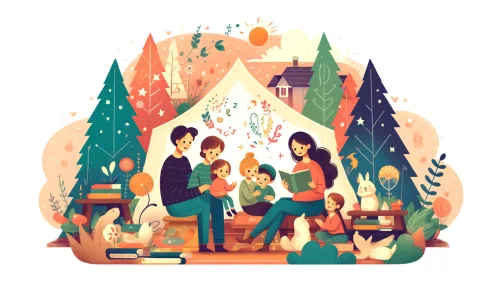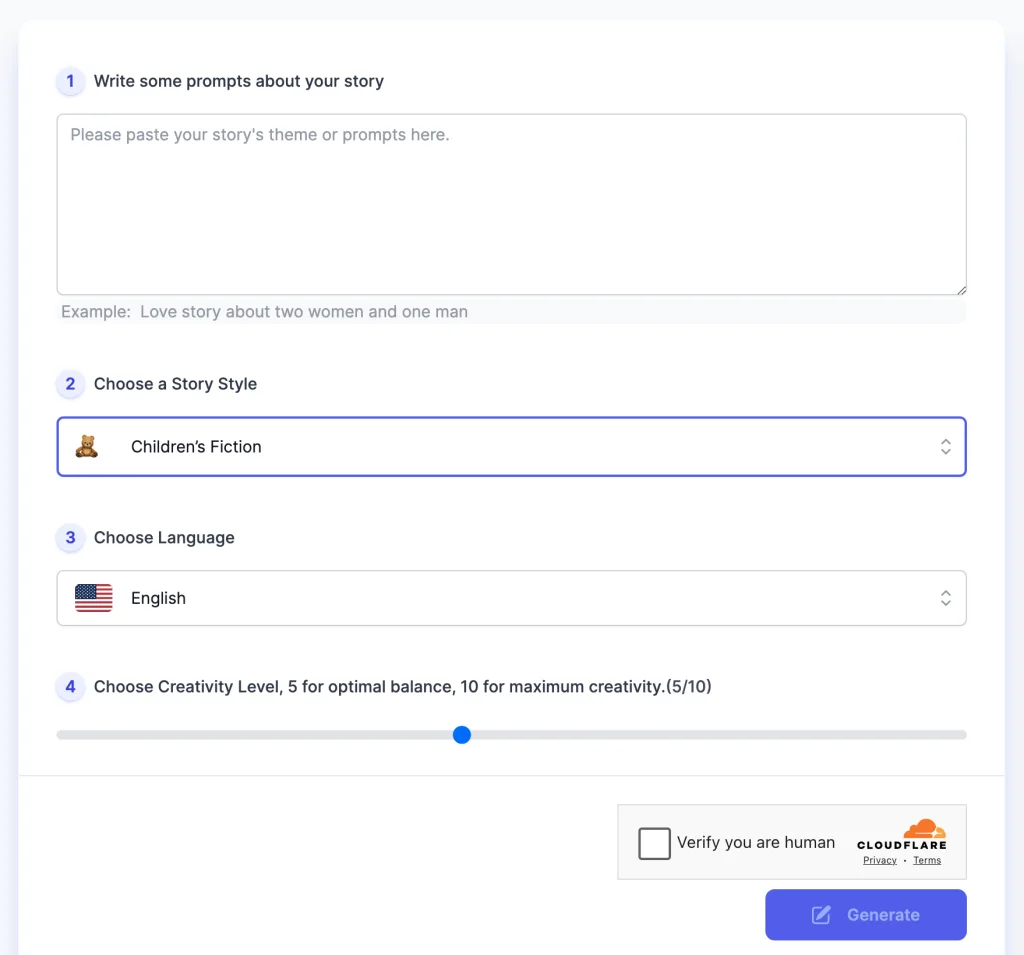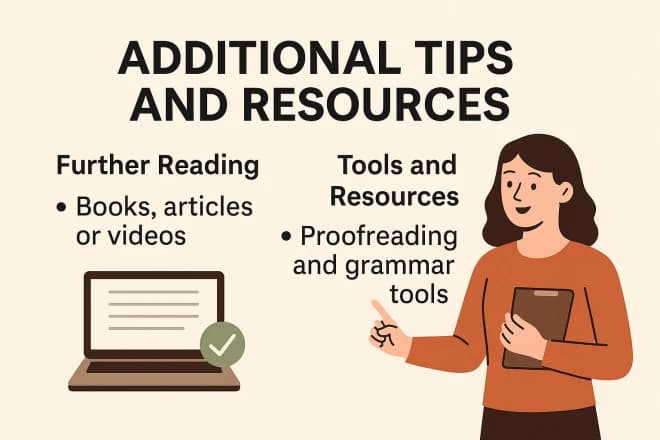Unlock Insights: Find the Answers You Seek on Our Blog
Practical Guide to Children’s Storytelling: Ideas & Tips for Family Fun
By Evelyn Sterling
Storytelling is a vital aspect of family bonding, acting as a bridge between generations . In the family environment, it is more than a pastime; it’s a tool for nurturing connections, building shared memories, and teaching values.
Storytelling within the family strengthens relationships, offering a platform for mutual expression and learning. It enhances the family bond, promotes emotional development, and establishes a sense of community.
This blog post would serve as a comprehensive guide for parents and guardians looking to engage in storytelling with their children, providing practical advice, creative ideas, and resources to get started.
Why Create Stories with Your Children?
Engaging in the art of storytelling with children is not just a way to pass time; it’s a nurturing process that significantly contributes to their developmental journey. Here’s how:
Benefits for Children
- Creativity: Crafting stories stimulates children’s imagination, encouraging them to think outside the box and explore endless possibilities. This creative exercise helps them develop innovative thinking skills, which are valuable in academic settings and in solving everyday problems.
- Language Skills: Storytelling is a fun and effective way to enhance children’s vocabulary and understanding of language. As they narrate their tales, they learn new words, understand sentence structure, and practice articulation, which improves their communication skills and linguistic competence.
- Emotional Expression: Through storytelling, children can explore and express their emotions in a safe and supportive environment. It allows them to process their feelings, whether it’s joy, sadness, fear, or excitement, and communicate their experiences. This emotional literacy is crucial for their overall well-being and social interactions.
Benefits for Parents
- Insight into Children’s Thoughts: Listening to the stories children create offers parents a window into their minds. It reveals their interests, worries, dreams, and how they perceive the world around them. This insight is invaluable for parents seeking to understand and connect with their children on a deeper level.
- Stronger Relationships: Storytelling fosters an intimate bond between parents and children. It’s an activity that requires active participation and attentive listening, demonstrating to children that their thoughts and ideas are valued. This shared experience strengthens trust and affection, laying the foundation for a robust and enduring family relationship.
In conclusion, creating stories with children is more than just a playful activity; it’s an enriching experience that fosters creativity, language development, and emotional expression in children, while offering parents a deeper understanding of their children and strengthening familial bonds.

Getting Started with Storytelling: Generating Children’s Story Ideas
To make storytelling a cherished part of family life, it’s essential to establish an environment and routine that encourage the sharing of stories. Here’s how to create the perfect setting for your storytelling adventures:
Creating a Conducive Environment for Storytelling
- Designate a Special Storytelling Space: Choose a comfortable and quiet area in your home where you can gather without distractions. This could be a cozy corner with cushions, a tent made of blankets, or even under the stars in your backyard. The idea is to make this space inviting and special, signaling that it’s time for storytelling.
- Minimize Distractions: Ensure the storytelling space is free from interruptions like television, phones, or other electronics. This helps everyone in the family to be fully present and engaged in the story.
- Gather Storytelling Tools: While not always necessary, having some storytelling aids can enhance the experience. This could include books, picture cards, or objects that spark imagination and can be incorporated into the stories.
Tips on Setting Aside Regular Storytelling Times
Establish a Routine: Consistency is key in making storytelling a habit. Set aside a specific day and time each week for your storytelling session. Whether it’s every Sunday night, or a few minutes each bedtime, having a regular schedule helps children anticipate and prepare for this special time.
- Be Flexible and Responsive: While it’s important to have a routine, be open to spontaneous storytelling moments. If your child shows an interest or comes up with a story idea at an unexpected time, take the opportunity to explore it together.
- Involve Everyone: Make sure all family members get a chance to tell their stories. This not only makes it more engaging for everyone but also encourages a variety of storytelling styles and perspectives.
By creating a conducive environment and setting aside dedicated times, storytelling can become a treasured and enriching activity for the whole family. It’s about building a tradition that fosters creativity, communication, and connection, setting the stage for countless shared adventures and memories.
Finding Inspiration for Your Stories
Crafting a captivating story doesn’t require looking far and wide; often, the best tales are hidden in the mundane aspects of daily life or within the boundless realms of a child’s imagination. Here’s how you can unearth these storytelling gems:
Using Everyday Experiences and Observations
- Draw from Daily Life: Everyday activities and experiences can spark story ideas. A trip to the grocery store, a family picnic, or a funny incident at home can all be transformed into engaging stories. Discussing the day’s events can also lead to the discovery of storytelling material.
- Observe Nature and Surroundings: Encourage children to observe the world around them and use these observations as story starters. The changing seasons, a bird building its nest, or the stars at night can all inspire wonderful narratives.
Drawing from Children’s Interests and Imaginations
- Tap into Their Interests: Children often have vivid imaginations and unique interests. Ask them about their favorite animals, places, or hobbies, and use these topics as the foundation for a story. This not only makes the story more engaging for them but also shows that you value their interests.
- Encourage Imaginative Play: Children often create intricate stories during play. Listen to their pretend play sessions, and you’ll find a wealth of ideas that can be expanded into longer stories.
Exploring Books, Movies, and Other Media for Ideas
- Get Inspired by Literature and Film: Books and movies are rich sources of narrative ideas. Discuss the stories you read or watch together, and think about how you can create your own versions or spin-offs. What if the story ended differently, or what if another character was the hero?
- Mix and Match from Different Sources: Combine elements from various stories to create something unique. Maybe a character from a book meets someone from a favorite movie in a completely new setting. This method can lead to inventive and unexpected storylines.
By weaving together elements from daily life, children’s interests, and existing narratives, you can create a rich tapestry of stories that are both relatable and exciting. This approach not only makes storytelling more accessible but also turns it into a fun and imaginative journey for the whole family.
Elements of a Good Children’s Story Idea
A compelling children’s story is not just about the sequence of events but how those events unfold through the eyes of its characters, in a setting that sparks the imagination, and within a plot that holds the audience’s attention. Here’s how to weave these elements together:
Characters: Creating Relatable and Dynamic Characters
- Relatability: Characters in children’s stories should be relatable to the young audience. They can be children themselves, animals, or even inanimate objects brought to life. What’s important is that they have qualities or face challenges that children can understand and empathize with.
- Growth and Development: Good characters often evolve throughout the story. They learn something, change in some way, or overcome a problem. This development helps convey messages and values and keeps the story engaging.
- Diversity and Representation: Including a diverse range of characters can help children see themselves and learn about others. It’s important to present various backgrounds, cultures, and abilities in stories to foster inclusivity and empathy.
Setting: Building a World That Captivates Young Minds
- Imagination and Detail: The setting of a children’s story should be described vividly to captivate the imagination. Whether it’s a fantastical world or a familiar setting, the details should be rich enough to transport the listener into the story.
- Interactive Environments: Settings that children can mentally interact with or relate to their own experiences can enhance engagement. For example, a magical forest with hidden treasures or a school with secret passages invites children to explore alongside the characters.
Plot: Crafting Engaging and Age-Appropriate Narratives
- Structure and Simplicity: A clear beginning, middle, and end help children follow the story. The plot should be straightforward enough for them to understand, with a logical sequence of events.
- Conflict and Resolution: Every good story needs a conflict or a problem that the characters must navigate. This not only drives the narrative forward but also teaches problem-solving and resilience. The resolution should be satisfying, offering closure and a lesson learned.
- Interactive Elements: Including elements that allow children to participate, like guessing what happens next, making choices for the characters, or solving puzzles, can make the story more engaging and interactive.
Creating a good children’s story involves blending relatable characters, imaginative settings, and engaging plots. These elements, when thoughtfully crafted, can spark curiosity, teach valuable lessons, and provide a memorable storytelling experience for children.
Utilizing AI Story Generators for Children’s Story Ideas
AI Story Generator, a fascinating integration of technology and creativity designed to inspire storytellers.
What is an AI Story Generator?
An AI Story Generator is a software application that uses artificial intelligence, particularly natural language processing (NLP) and machine learning algorithms, to create stories automatically. These generators are capable of producing narratives based on given prompts or themes, offering a wide range of story ideas that can serve as a starting point or inspiration for your own storytelling.
This tool can generate diverse story elements, such as characters, settings, plots, and conflicts, providing a creative springboard for parents and children to develop their unique tales.
How to Use an AI Story Generator for Children’s Story Ideas

- Inspiration Phase: Think about what kind of story you and your child would like to create. Maybe it’s an adventure story featuring a brave kitten or a magical tale set in an enchanted garden.
- Prompt Entry: In the first field where it says “Write some prompts about your story,” enter the theme or elements you’ve brainstormed. For example, “A magical adventure of a brave kitten in an enchanted garden.”
- Selecting a Story Style: Click on the dropdown menu currently set to “Children’s Fiction” to confirm the genre, or change it if you want to explore different story styles.
- Language Selection: Make sure “English” is selected, unless you prefer the story to be generated in a different language.
- Creativity Level: Move the slider to select how creative you want the AI to be. The middle is a balance, while the far right will give the most imaginative (and potentially zany) results.
- Generate Your Story: Once you’re happy with your choices, click the “Generate” button. There’s a “Verify you are human” box, make sure to check it before clicking to proceed.
- Review and Edit: After the story is generated, read through it together with your child. You can add your own twists, edit parts, or even combine multiple stories for a customized tale.
This process should make it fun and easy for parents to quickly create new and exciting stories with their children!
Interactive Storytelling Techniques
Interactive storytelling transforms the experience from mere listening to active participation, making the story come alive for children. Here are some techniques to make your storytelling sessions more engaging:
Using Voice Modulation and Body Language
- Voice Modulation: Changing your tone, pitch, and pace can convey different emotions and characters, making the story more dynamic. Use a high pitch for excitement, a slow pace for suspense, or a soft tone for tender moments. This variety keeps children engaged and helps them understand the emotional context of the story.
- Body Language: Incorporate gestures, facial expressions, and movements to illustrate the story. Acting out scenes or mimicking character actions can make the narrative more vivid and understandable. This physical aspect of storytelling not only entertains but also aids in the child’s comprehension of the plot and characters.
Involving Children in Story Creation and Telling
- Co-Creation: Encourage children to contribute to the story, whether by deciding what happens next, inventing character names, or choosing settings. This involvement makes them feel invested in the narrative and sparks their creative thinking.
- Role-Playing: Assign roles to children, letting them act out parts of the story. This active participation enhances their understanding of the characters and plot, and it’s also a fun way to develop their acting and speaking skills.
Adding Visual Aids, Like Drawings or Props
- Drawings and Illustrations: Use drawings, either pre-made or created during the storytelling session, to illustrate scenes and characters. This visual element helps children visualize the story and can aid in their understanding and memory of the events.
- Props and Costumes: Integrate simple props or costumes to bring the story to life. Items like hats for different characters, a makeshift wand, or a toy that’s pivotal to the story can make the experience more immersive and memorable.
These interactive storytelling techniques not only make the story more engaging for children but also enhance their listening, comprehension, and creative skills. By incorporating voice modulation, body language, child participation, and visual aids, storytelling becomes an active and enriching experience for both the storyteller and the listeners.
Conclusion
Storytelling is a crucial tool for family connection and communication, strengthening bonds, sparking creativity, and fostering a deep sense of belonging. It serves not only to enhance relationships but also to pass down values, enriching the family’s sense of unity and tradition.
AI Tools Categories
Browse all AI tools by category
All AI Tools
229Amazon
5AI Writing Generator
85Article & Content Writing
35Branding & Identity
54Content Generation
170Creative Ideas
32Educational Resources
34E-commerce
14Etsy
6Events & Celebrations
13Facebook
6Gaming & Fun
5Instagram
3Lifestyle & Personal
8LinkedIn
6Marketing & SEO
40Poem & Lyrics Writing
19Professional Documents
31Social Media
44Story & Book Writing
49Text Effects
14TikTok
7Twitter
3Writing Enhancement
36YouTube
11
Highly rated and most popular AI tools curated by our experts
Recently added AI tools that are gaining traction
- AI Post Generator

- AI Bullet Point Generator

- AI Discussion Post Generator

- AI 2 Weeks Notice Letter Generator

- AI Content Creation Ideas Generator

- AI Radio Ad Script Generator

- AI Podcast Script Generator

- AI Resume Objective Generator

- AI Resume Headline Generator

- AI Password Generator

- AI Snapchat Caption Generator

- AI Snapchat Username Generator

- AI Pinterest Board Name Generator

- AI LinkedIn Experience Description Generator

- AI Twitter Hashtag Generator

- AI YouTube Short Idea Generator

we prioritize displaying the latest content closely related to the current blog post.







